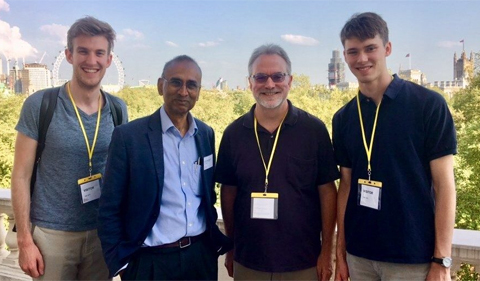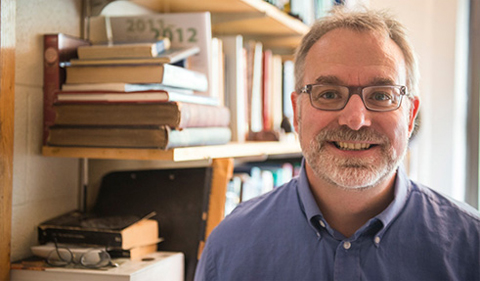
NQPI member David Drabold (center right) poses in Cambridge, England with Nobel laureate Venkatraman “Venki” Ramakrishnan (center left) and his sons, Will (left) and Edward (right). Drabold spent last spring at Trinity College during his sabbatical. (Photo courtesy of David Drabold)
By Ryan Flynn
NQPI editorial intern
One might not think history and physics regularly coincide. However, Distinguished Professor of Physics and Nanoscale and Quantum Phenomena Institute member Dr. David Drabold steeped himself in both this past spring by taking sabbatical at Trinity College in Cambridge, England.
While in Cambridge, Drabold met with long-acquainted colleagues and enjoyed the rich, historical landscape of a city where the likes of Sir Isaac Newton, Bertrand Russell, Francis Bacon and other great minds have gathered for centuries.
“It’s an everyday event to eat lunch or dinner with a Nobel Prize winner,” Drabold said.
He reconnected with many long-standing associates, such as his past collaborator, Trinity College professor of physical chemistry Dr. Stephen Elliott. In Cambridge, Drabold and Elliott worked on the theory of amorphous silicon this year, focusing on its electronic structure.
As a visiting fellow commoner, a title given to visitors of Cambridge who are within the school’s highest standings, this was Drabold’s third visit to Trinity College. He spent six months there in 2001, and from 2008 to 2009 Drabold was a Leverhulme Professor of Chemistry. The position included a grant by the UK Leverhulme Academic Trust to enhance the skills of academic staff within the institution.
Drabold submitted two academic papers while in Cambridge. He and his collaborators studied amorphous carbon and showed that it consists of interconnected pieces of an exotic material, amorphous graphene. A two-dimensional crystal variant, amorphous graphene is comprised of carbon atoms arranged in rings of pentagons, hexagons and heptagons. Read more about his work.
In a different project, Drabold researched the transport of charge through alumina materials alloyed with copper to understand how conducting-bridge RAM works; a form of memory storage that can retrieve stored data without requiring a continuous power source. Read more about his work.
In November, Drabold submitted a paper on Machine-Learning-derived, melt-quench models of amorphous silicon and its associated electronic properties to Angewandte Chemie. This paper is a direct outcome of his UK work.
Another old friend in Cambridge was OHIO alumnus, 2009 Nobel laureate Dr. Venkatraman “Venki” Ramakrishnan. Ramakrishnan was knighted by the Queen in 2012 for services to molecular biology. He invited Drabold and his family to the Royal Society in London, where he is currently president, and gave them a private tour.
“That was fascinating because we saw lots of history of the Royal Society,” Drabold said. The Royal Society, founded in 1660, is the oldest national scientific society in the world. Drabold said Ramakrishnan’s invitation was “the kind of thing one never forgets.”
Drabold summed up the rewards of his sabbatical succinctly: “It’s always fantastic to work with the scientific group of Stephen Elliott,” Drabold said. “Of course it was great seeing Venki. And frankly, I just love being in Cambridge.”



















Comments